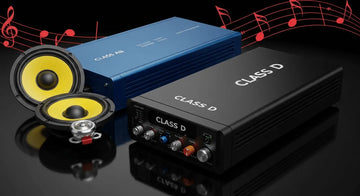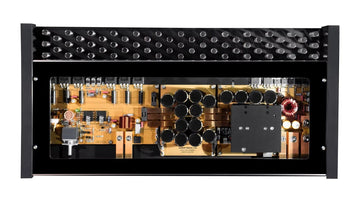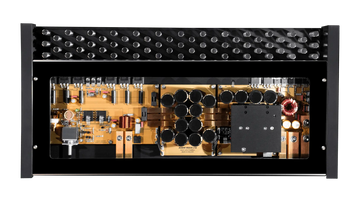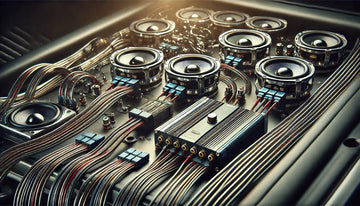Class A Amplifiers
Featured Products
Audio Wave Excel CA | 2 Channel Class A Amplifier | Previous Demo
TRU Technology Billet B22-A v2.5 - 2-Channel Class A Amplifier
Audio Wave Aspire Pro V2 Class A 2-Channel Amplifier
Audio Wave Aspire Pro V2 Class A 2-Channel Amplifier | Previous Display
Audio Wave CR-30X - Class A Monoblock Amplifier
All products loaded
Unleashing Pure Sound: The Ultimate Guide to Class A Car Amplifiers

For the serious car audio enthusiast, a vehicle is more than transportation—it's a personal concert hall on wheels. The pursuit of perfect sound reproduction is a journey of passion and precision, aiming for an immersive experience that brings music to life. In this quest for ultimate audio fidelity, one component stands out for its commitment to purity: the Class A amplifier. While other designs prioritize efficiency or power, the class a car amp is built for a single, uncompromising purpose: to deliver the most accurate, natural, and distortion-free sound possible. This guide delves into these audiophile-grade components, exploring what defines them, their unmatched sonic character, and the practical considerations for integrating one into your high-end system.
What Defines a Class A Car Amplifier?
In the world of amplifier classes, each design is defined by its circuit design and how its output transistors behave. While Classes AB and D are industry standards for their balance of performance and efficiency, Class A operation follows a fundamentally different philosophy. A Class A amplifier's circuit is designed so its output transistors conduct current continuously, regardless of whether an audio signal is present. They are biased to be "always on" at full capacity.
To understand this, imagine a water faucet. In a Class D or AB amplifier, the faucet turns on and off rapidly to control the water flow (the audio signal). In a Class A design, the faucet is left wide open, running at full blast. The audio signal's job is not to turn the flow on or off but to direct the already-flowing stream. This constant current flow ensures the amplifier is always ready to reproduce the audio waveform instantaneously without switching delays. The entire audio signal, both the positive and negative halves of the waveform, is handled by the same set of transistors. This is a stark contrast to a Class AB amplifier, where one set of transistors handles the positive half and another handles the negative, switching between them near the zero-voltage point. This "always on" principle is the secret to a Class A amplifier's renowned audio fidelity, but it also comes with significant trade-offs in power output and efficiency.
The Unmatched Sound Quality of Class A Amplifiers for Car Audio
The primary reason any audiophile seeks a class a amplifier car audio setup is for its exceptional sound quality. The unique operating principle of a Class A amp translates directly to a sonic signature often described as warm, smooth, and incredibly natural. Its most significant advantage is the complete elimination of crossover distortion. In Class AB amps, the minute delay as the output stage switches from positive to negative transistors can introduce slight distortion at the signal's zero-crossing point. While often inaudible during casual listening, this distortion can obscure fine details and create a subtle harshness or "grain" in the music.
Because a Class A amplifier's transistors never switch off, there is zero crossover distortion. The audio signal is reproduced as a single, seamless, and pure waveform, resulting in a level of clarity and detail that is second to none. Listeners often report hearing micro-details in familiar recordings for the first time—the subtle decay of a cymbal, the sound of a guitarist's fingers sliding on the strings, or the faint echo of a recording venue. This contributes to an exceptionally realistic and three-dimensional soundstage. Instruments and vocals have a distinct place in the sonic image, with palpable air and separation between them. The experience is less like listening to speakers and more like being present at the original performance. Musical genres that thrive on nuance, dynamics, and acoustic realism—such as jazz, classical, and high-resolution audiophile recordings—benefit immensely from the fidelity of Class A amplification.
Understanding the Trade-offs: Power, Heat, and Efficiency
The pursuit of audio perfection with a Class A amplifier involves significant compromises. The "always on" design that produces such pure sound is also the source of its primary drawbacks: poor efficiency and high heat. A typical Class A amplifier has an efficiency rating of only 20-25%. This means that for every 100 watts of power it draws from your car's electrical system, only 20-25 watts are converted into sound. The remaining 75-80 watts are dissipated as pure heat. This happens continuously, even when no music is playing. Consequently, Class A amps run extremely hot and require massive, heavy-duty heat sinks and excellent ventilation to operate safely.
This high power consumption and heat generation present several real-world installation challenges:
-
Electrical System Strain: The constant high current draw places a significant load on your vehicle's charging system. In many cases, installing a powerful Class A amp will require upgrading to a high-output alternator and a more robust AGM (Absorbent Glass Mat) battery to keep up with the demand. The "Big Three" wiring upgrade (upgrading the main power and ground wires between the battery, alternator, and chassis) is often considered essential.
-
Wiring: Due to the high current, using thick-gauge, high-quality OFC (Oxygen-Free Copper) power and ground wire is non-negotiable. Undersized wiring can starve the amplifier, limit its performance, and create a serious fire hazard.
-
Physical Size & Placement: The need for enormous heat sinks means a car amplifier class a is typically much larger and heavier than a Class D amplifier of comparable power. Finding a suitable mounting location that provides ample space for air to circulate and dissipate heat is critical to prevent the amplifier from overheating and entering thermal protection mode.
Choosing the Right Class A Car Amplifier for Your Setup
Selecting a car amplifier class a requires a more thoughtful approach than simply looking for the highest power rating. The goal is to achieve system synergy, where every component works in harmony. First, consider your speakers. It's crucial to match the amplifier's RMS (continuous) power output to your speakers' power handling capabilities. Class A amps are valued for quality, not quantity; they are best suited for driving high-quality component speakers or tweeters in an active setup, rather than power-hungry subwoofers.
Impedance matching is also key. Most Class A car amplifiers are designed to be stable into 4-ohm loads, delivering their cleanest power at this impedance, so pay close attention to the manufacturer's specifications. Also, consider the number of channels you need. A 2-channel Class A amp is a popular choice for powering a high-end front soundstage, which is the most critical element for stereo imaging. When evaluating different models, look beyond the specs. Examine the build quality, the internal components like capacitors and transistors, and the brand's reputation. Esteemed audiophile brands invest heavily in research and development to perfect their circuit designs. Finally, be realistic about your budget. Due to their complex design, high-quality components, and niche market, true Class A amplifiers represent a significant investment and are positioned at the premium end of the car audio market.
Optimizing Your System: Installation and Integration Tips
Investing in a high-end Class A amplifier is only part of the process; proper installation and system tuning are what unlock its full sonic potential. Even the best amplifier will perform poorly if installed incorrectly. The foundation of any great audio system is its power and ground wiring. A Class A amp's high current demand requires a very short, solid ground connection to a bare-metal point on the vehicle's chassis. Use the same gauge wire for your ground as you do for your power wire. Signal integrity is just as important. Use high-quality, well-shielded RCA interconnects to run the audio signal from your head unit or processor to the amplifier, routing them away from power cables to prevent induced noise.
As mentioned, amplifier placement is critical for thermal management. Never install a Class A amp in a tight, enclosed space or cover it with carpets or panels, as it needs to breathe. If necessary, consider adding cooling fans to assist with ventilation. Once installed, the system must be tuned carefully. Setting the amplifier's gain correctly is paramount to achieving a clean signal without clipping or distortion. Using a Digital Signal Processor (DSP) is highly recommended in a system of this caliber. A DSP allows for precise control over crossovers, time alignment, and equalization, enabling you to tailor the sound perfectly to your vehicle's acoustics and your listening preferences. Given the cost of the components and the complexity of installation and tuning, professional installation is strongly recommended for anyone who is not an experienced car audio installer.
Discover Our Premium Class A Car Amplifier Collection
The journey to true audiophile car audio is one of deliberate choices, where sound quality is the ultimate goal. A Class A car amplifier represents the pinnacle of this pursuit, offering a level of warmth, detail, and musicality that is simply unmatched. It is the choice for the discerning listener who values purity over power and is willing to accommodate its unique demands for a truly superior listening experience. If you are ready to elevate your mobile audio system from simply loud to breathtakingly realistic, you are in the right place.
We invite you to explore our curated collection of the world's best car audio amplifiers, featuring premier Class A models from the most respected brands in the industry. Each amplifier in our selection has been chosen for its exceptional build quality, proven performance, and ability to create a truly immersive soundstage. Browse our offerings to compare class a amplifiers and find the perfect centerpiece for your premium sound system. Take the final step in your quest for perfect sound and transform your daily drive into a moving musical masterpiece.
Class A Amplifiers
Frequently Asked Questions
What is a Class A amplifier?
Are Class A amplifiers better?
What is a Class A and Class B amplifier?
What are the disadvantages of Class A?
Which class amplifier is best for sound?
Related Articles

Class AB vs Class D Amplifiers: Which One Should You Choose?

The Best Class A Amplifier: Key Features and Benefits Explained

Class A Car Amplifiers: The Gold Standard in Sound Quality









